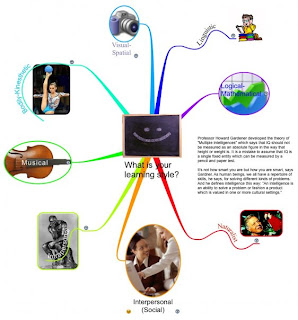Actually, this week discussion about
learning styles is my one of my favorite.
This problem is familiar
to every teacher but still raises a lot of questions and arguments. According
to Wikipedia,
learning styles are various approaches or ways
of learning. They involve educating methods, particular to an
individual, that are presumed to allow that individual to learn best (1).
Teaching ESL/EFL we try to use different
techs and techniques to satisfy our learners. But our students are different so
we should use a complex diverse methodology to make our students perceive
information from as many angles as we can provide.
AUDITORY ESL LEARNING STYLE are the
type who receive and
retain information from listening. They will respond well
to games that involve repetition, dictation, and music.
Simple poems with a strong swing such as limericks are a
good way to start, and you may even introduce some Jazz
Chants for more conservative adults. EFL students often admit that while they
may advance rapidly in a classroom, out in public they have more
trouble following the native speakers. This can be
addressed by using tapes and videos to listen for key words
and pick out the general meaning of a dialogue.
Listening memory games, such as 'My name
is Mary, I come
from Milwaukee..'
are terrific for the auditory learner.
You can expand on this by keeping a record of the words
used and subsequently asking the students to utilize them
again to form new sentences. Quiz games such as Jeopardy
can also be a fun and instructive way to teach language,
and students can be encouraged to extend their vocabulary
by fostering a mild spirit of competition.
VISUAL ESL LEARNING STYLE are the
students that most
traditional teaching methods were developed for. They have
a high capacity for retaining information from written and
illustrated text. Flash cards and videos will also prove
good ESL learning tools for these students.
You can make game-boards after the fashion of popular
titles such as Life - this can become a role playing game,
'A Day in the Life', where students can participate in
role-playing scenarios determined by the rolling of a dice
and drawing of cards. Memory cards matching games can be a
fun activity for pairs - have them use the word in a
sentence when they find a match!
Reading Treasure hunts can work well to teach recognition
of the parts of speech; just hand out colored pencils and
designate a color for each type. This can also teach
students to skim and pick up general meanings of words from
context. Let them rewrite sentences too - try captions for
pictures or comics to add a humorous note!
TACTILE AND KINESTHETIC ESL LEARNING STYLES
The remaining two types of learners are
similar enough that most games
can be adapted for either learning style. Tactile and
kinesthetic ESL learners and comprehend faster when
participating in hands-on activities, and take in
information using their whole bodies. Games for these types
can actually benefit the whole class; studies have shown
that ESL students as a whole show a marked preference for
this style of teaching, and games of this sort are a
perfect way to introduce variety into the classroom!
Probably the most familiar 'touch' game involves a bag with
different items inside. The participants have to feel the
items through the cloth and guess what they are. A
variation that is helpful for ESL students is to have them
describe the items so that classmates can guess their
identity - be prepared for some laughs!
Charades is a perfect example of a game that uses the whole
body. Have cards prepared with easy titles such as popular
TV shows, and get everyone involved! Ask students to come
up with titles too - perhaps they can give the English
translation of a favorite childhood book or movie.
Crafts are a wonderful option when it comes to hands-on
learning. Coloring and labeling maps is a good exercise,
and can be done individually or as a group. Introducing
building toys such as Legos can help bridge the gap between
the learning styles as you can use written and or verbal
instructions for the Auditory and Visual ESL learners in
the class.
A wide variety of language game ideas can
be implemented in
your ESL classroom to embrace all the types of ESL learning
styles. Remember, have fun! Your students will all benefit
from a diversified learning experience (2).
Resources:




